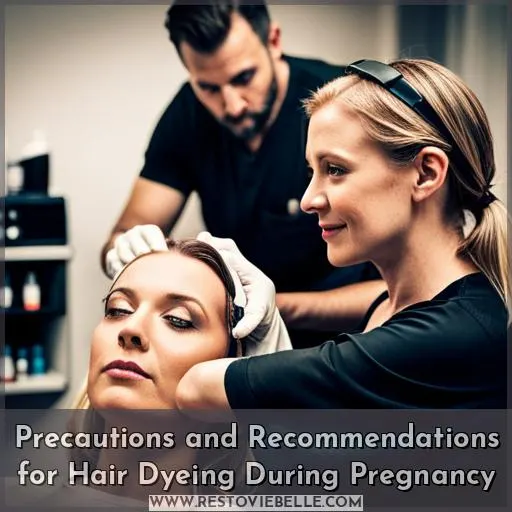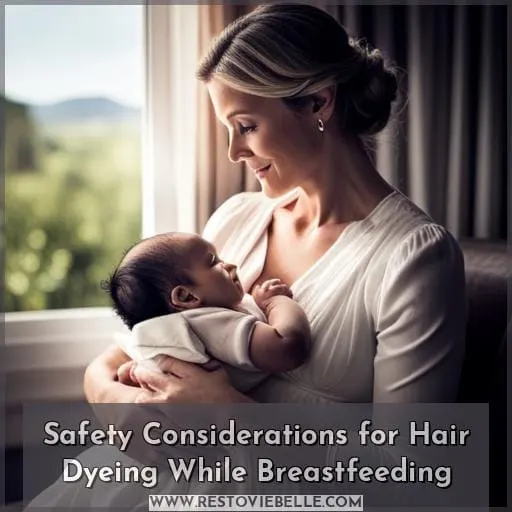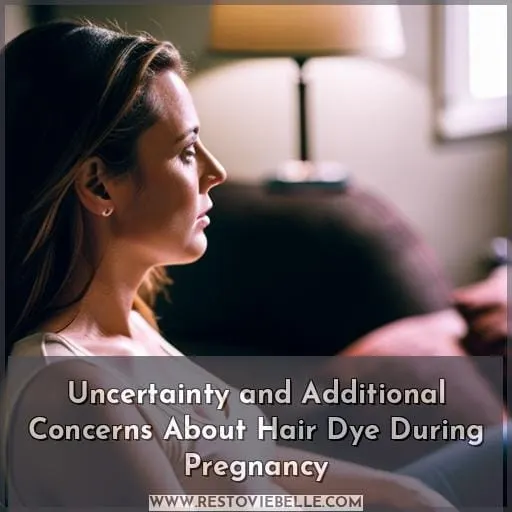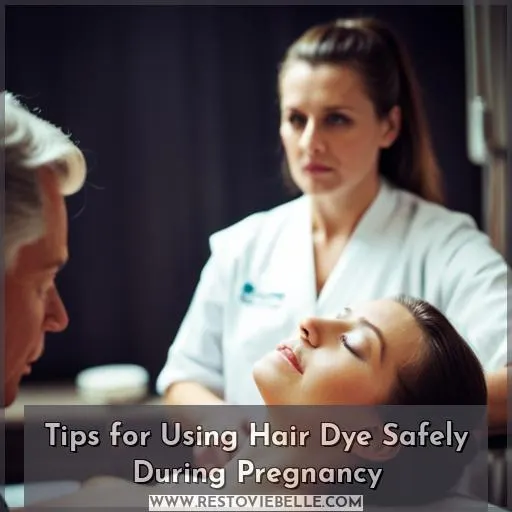This site is supported by our readers. We may earn a commission, at no cost to you, if you purchase through links.
 Tired of seeing your roots and grays? Have you been wondering if it’s safe to dye your hair when pregnant? Many women are hesitant to use regular hair dyes during this time, but research has shown that most chemicals found in both semi-permanent and permanent dyes are not highly toxic.
Tired of seeing your roots and grays? Have you been wondering if it’s safe to dye your hair when pregnant? Many women are hesitant to use regular hair dyes during this time, but research has shown that most chemicals found in both semi-permanent and permanent dyes are not highly toxic.
With the right precautions, you can color your locks without compromising the health of yourself or baby. Before considering a new hue for those glossy tresses, here’s what you need to know about dyeing while expecting.
Table Of Contents
- Key Takeaways
- Is It Safe to Dye Your Hair During Pregnancy?
- Precautions and Recommendations for Hair Dyeing During Pregnancy
- Safety Considerations for Hair Dyeing While Breastfeeding
- Uncertainty and Additional Concerns About Hair Dye During Pregnancy
- Tips for Using Hair Dye Safely During Pregnancy
- Conclusion
Key Takeaways
- Dye hair during the second trimester for safer results.
- Take precautions such as wearing gloves and seeking professional advice.
- Consider using semi-permanent vegetable dyes or natural ingredients.
- Perform patch tests and strand tests to check for any allergic reactions.
Is It Safe to Dye Your Hair During Pregnancy?
You may be wondering if it’s safe to dye your hair during pregnancy, and the answer is – with caution. Hair dye safety during pregnancy has been widely debated due to the potential for chemical exposure.
Generally, experts consider hair dye not toxic when used in moderation. However, they suggest waiting until after the first 12 weeks of pregnancy before using any type of hair dye product.
To reduce risks further, it’s best to wear gloves when applying color and highlight instead of coloring all over for lower absorption levels. Professional advice should also be sought out before dyeing, as well as making sure there is adequate ventilation in an open area free from fumes or irritants that could cause harm during this time period.
Semi-permanent vegetable dyes like henna can be a safer alternative, although they still warrant caution. Anything applied topically can potentially enter into one’s bloodstream and affect baby health developmentally down the line.
Thus, reducing risk by following certain precautions is essential when considering options on how one wishes to appear aesthetically at this delicate time frame.
Precautions and Recommendations for Hair Dyeing During Pregnancy
When considering hair dyeing during pregnancy, timing and the choice of product are essential. It is recommended to wait until after the first 12 weeks of pregnancy before beginning any coloring process; vegetable-based semi-permanent dyes such as henna may be a safer alternative than chemical products.
Additionally, it’s advisable to conduct a strand test prior to any coloring session and consult with your hairdresser for professional advice on minimizing exposure time and maximizing ventilation while using hair dye products.
Timing and Pregnancy Trimesters
It’s best to wait until the second trimester of pregnancy before dyeing your hair, so as not to take any unnecessary risks – better safe than sorry!
The first trimester is a crucial time for fetal development, and it’s wise to be cautious about chemical exposure. Semi-permanent vegetable dyes like henna are a safer option, while highlighting can reduce absorption on the scalp or in the bloodstream.
During each pregnancy trimester, there may be changes in how hair responds to coloring or perming.
Always remember that safety comes first when selecting color options, and make sure chemicals don’t enter your eyes by wearing gloves throughout application.
With careful consideration and attention paid towards minimizing potential risk factors associated with using hair dye during this special time period, you’ll have no problem finding just the right look!
Choosing Safer Hair Dye Options
When expecting, it’s important to take extra caution in your beauty routines and consider safer hair dye options. Natural alternatives like henna are safe during pregnancy and provide a gentle color.
Test strands before coloring the whole head, as pregnancy can affect how hair responds to dyes. Always read instructions on product labels carefully and use gloves when applying chemicals to prevent allergic reactions or staining of skin.
Look for brands that are free from harsh chemicals such as PPDs (para-phenylenediamine) which may increase breast cancer risk with high exposure levels.
Conducting a Strand Test and Seeking Professional Advice
Before taking the plunge, consider doing a strand test and talking to a hair professional for advice. This will help determine if you have any allergies or sensitivities to chemicals used in hair treatments, as well as check compatibility between your natural color and desired shade.
Additionally, performing a patch test can help identify potential adverse reactions before dyeing your entire head of hair.
Minimizing Chemical Exposure and Maximizing Ventilation
To minimize chemical exposure, wear gloves and ensure that the area is well ventilated. Working in a space with good air circulation can help reduce fumes when dyeing your hair while pregnant. Open windows to allow fresh air in or use a fan to create airflow throughout the room.
Make sure everyone involved wears protective gear like masks and goggles for added safety measures. Additionally, avoid working in poorly lit areas as this increases eye strain that may cause irritation from chemicals or dyes used during the treatment processes of pregnancy-related hair changes.
Safety Considerations for Hair Dyeing While Breastfeeding
It is important to consider the potential risks and benefits when dyeing your hair while breastfeeding. Limited information suggests that it is likely safe, as very little of the dye chemicals enter into your bloodstream or breast milk.
While there are some safety concerns due to unknown risks from hair dyes, taking precautions can minimize any minor risk factors associated with this activity.
Potential risks and benefits
Considering the potential risks involved, it’s wise to weigh up the pros and cons of hair dyeing while breastfeeding, like an alchemist’s journey towards finding a precious elixir.
Hair dyes containing chemicals can increase skin sensitivity during pregnancy. However, some semi-permanent vegetable dyes, such as henna, are safe alternatives.
Breastfeeding safety remains uncertain due to limited research evidence and lack of FDA approval for most cosmetics, including hair dye products.
Very little chemical absorption occurs through the scalp or breast milk. However, fake tan should be avoided altogether when breastfeeding due to its active ingredients being transferred via urine into the baby’s system if ingested directly from the mother’s body!
Best practices and guidelines
When breastfeeding, you should take extra precautions to ensure the safety of hair dyeing and follow guidelines for best practices. It is recommended to choose a dye with natural ingredients or semi-permanent vegetable dyes like henna.
Timing your coloring in the second trimester may be wise. Performing a strand test before full application will help determine how your hair reacts to color changes during pregnancy. Good ventilation is essential when using any kind of chemical product on the scalp and skin.
Open windows are advised for better air circulation. Lastly, remember to wear gloves throughout the process and avoid any contact between your eyes and the product at all costs.
Alternatives and safer options
If you’re looking for safer alternatives to hair dye while breastfeeding, try semi-permanent vegetable dyes such as henna. But is it really the safest option? Henna offers a variety of benefits with low-risk haircare.
Vegetable dyes are natural options and offer an alternative to chemical-free coloring.
For pregnant women who wish to color their hair without exposing themselves and their baby to potentially harsh chemicals, exploring different natural options like henna can provide a safe solution that won’t compromise your desired result.
Uncertainty and Additional Concerns About Hair Dye During Pregnancy
Despite the generally accepted safety of hair dye during pregnancy, there remain some uncertainties and additional concerns that should be noted.
Skin sensitivity increases during this time, raising concerns about the absorption of topical chemicals through the scalp or skin.
Dyeing with bleach, relaxers, or curling solutions poses similar risks as hair dye while pregnant. However, highlighting can reduce chemical absorption from these products by the scalp or bloodstream.
It is highly recommended to wear gloves to prevent staining and avoid allergic reactions when using dyes on your locks. Patch testing before color application is a wise decision because it helps identify potential adverse reactions such as itchiness, pain, redness, swelling, and dry skin – common signs of contact dermatitis.
These reactions could indicate that it’s best to wait until delivery before dyeing your tresses again.
Lastly, though not deeply researched yet, chemicals in hair dyes may increase the risk of breast cancer.
Tips for Using Hair Dye Safely During Pregnancy
Pregnancy can alter your skin’s sensitivity and even change the condition of your scalp. It is important to be mindful when using hair dye during this time, especially if you are considering patch testing or may have an adverse reaction.
Taking precautionary steps such as wearing gloves and following directions precisely will help ensure a safe coloring experience for both mom and baby.
Being Mindful of Skin Sensitivity and Scalp Conditions
Be mindful that skin sensitivity and scalp conditions during pregnancy can increase the absorption of hair dye chemicals. To protect yourself and your baby, it’s important to be aware of how these factors may affect you.
If you have a pre-existing skin condition such as eczema or psoriasis, patch test before using any hair dyes to check for allergic reactions.
Additionally, broken or sunburned skin should be avoided on the scalp area when coloring your hair since this increases chemical absorption through direct contact with the affected area.
Lastly, pay attention to changes in your body due to pregnancy; they could impact how certain dyes react with your strands!
Patch Testing and Adverse Reactions
Before dyeing your hair while pregnant, it’s important to perform a patch test and be aware of potential adverse reactions. Signs like itchiness, pain, redness, or dry skin can occur in up to 10% of people who use permanent dyes.
To reduce the risk, check for rashes or broken skin on the scalp. Be wary of worsening eczema or psoriasis. Wear gloves during application and follow directions precisely. Avoid getting dye in the eyes.
Patch testing is crucial as pregnancy-related changes may affect how hair reacts to coloration products.
Wearing Gloves and Avoiding Eye Contact
To ensure your safety, wear gloves when handling hair dye and avoid getting it in your eyes. Skin sensitivity increases during pregnancy, making topical chemicals a potential risk to the baby. Gloves provide an extra layer of protection by preventing staining or allergic reactions from the hair dye’s chemicals.
Additionally, do not get any product in your eyes as this can cause serious injuries and blindness. Ensure you are working in a well-ventilated space to reduce fumes’ irritation that may occur due to chemical exposure while using hair dye products on pregnant skin areas.
Following these precautions helps protect both mother and child from unwanted harm associated with coloring their locks during pregnancy!
Following Hair Dye Instructions Precisely
Make sure to read and follow the instructions of your hair dye precisely for best results. Keep in mind that even small amounts of exposure to chemicals can be harmful, so it’s essential to use gloves when applying it and not get any into your eyes.
Doing a strand test beforehand is also recommended as pregnancy can affect how your hair reacts, leading to unexpected allergic reactions or discoloration. Furthermore, always make sure you are in a well-ventilated space while using hair dye.
By following these steps carefully, you ensure that the process goes smoothly with minimal risk for yourself and baby!
Conclusion
When you’re pregnant, you often have many questions about the safety of the products you use. Hair dye is no exception. You might be wondering if it’s safe to dye your hair while pregnant. The answer is surprisingly simple. Generally, experts consider hair dye to be safe during pregnancy, provided you follow a few simple guidelines.
Taking the necessary precautions, including waiting until after the first trimester, choosing semi-permanent or vegetable dyes, and reducing chemical exposure through gloves and ventilation, can minimize the potential risks of dyeing your hair while pregnant.
Therefore, you can safely dye your hair during pregnancy with a few extra considerations to keep you and your baby safe.










